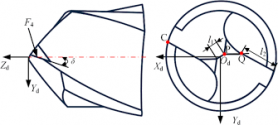Same family, CM is the export name, but they plan to get rid of these names in favor of YJ-83E because its way easier to explain what it is. Buyers want what the PLA is using and not some untried, export only weapon.
The canted nose appears to be using a digital infrared imaging seeker. What it does is to take the target image in infrared, match its pixel outline to a database of images, and once identified, homes in to it. This mainly meant against stationary or slow moving targets. This is a precision land strike weapon. This makes sense since a converted ASM for land strike is cheaper than a large dedicated cruise missile, and you can make more of these to a given budget.
The other nose is a dual active radar guided and infrared homing missile. The dome still has the traditional active guidance radar, and the infrared homing system is similar to what AAMs use. There's heat, it homes into that heat source. So if the missile is jammed by ECM or confused by chaff, it can revert to infrared mode and home in to what's hot on the target ship, and that's usually the funnel area, and when it does that, it will nail the engines. Infrared homing and infrared imaging should not be confused as the same.
Some ships are aware and prepared for infrared seeking in antiship missiles so they cover the funnel with an outer structure that allows ventilation to come in and cool the inner funnels. The outer housing also intends to hide the funnels. These design elements are evident in PLAN vessels. You can also add flares to your decoy system.
I just noticed this.
Regarding the canted nose seeker -- I do not think it is only using a ImIR seeker.
If it was only a ImIR seeker, they probably wouldn't have canted it in that manner, but they would've probably simply adopted a whole radome ImIR seeker like we've seen on some KD-88 variants before, such as below:

We also of course have the export variant of the canted nose YJ-83, dubbed CM-802B, that is described as having a "combined seeker".
To me, that suggests that the canted ImIR seeker is complemented by a radar seeker on the "top half" of the nose. Given the geometry of the upper half, I suspect the radar seeker is probably an entirely new array, perhaps even an AESA.
Either way I can't see the canted ImIR seeker being ImIR only -- because if the entire missile only has a ImIR seeker, there's no need to really cant it down in a way that only occupies the bottom half of the nose.

My personal hypothesis, is that the PLAN realized that a dual mode guidance (active radar and passive ImIR) would be necessary in the future. For the purposes of anti-ship missions, radar and ImIR offers the benefit of being able to detect and track your target in two mediums which makes defeating your seeker more difficult, as well as offering better performance in some environments (such as littorals, where ImIR is less affected by clutter).
A dual mode capability also means more in-built land attack capability for your AShM, because it means that the ImIR guidance can allow you to engage land targets more easily than a radar seeker can.
In pursuit of a dual mode guidance solution, they went for two routes, the first being adding a small side mounted ImIR seeker that can be installed to existing YJ-83 missiles without substantial modification (retaining the same existing radar seeker as well).

However, they also developed a clean build more capable YJ-83 variant which combines a larger and more integrated canted ImIR seeker, but which retains sufficient radome volume for a new, likely smaller and more capable radar seeker on the top half of the nose.
Frontal shots of the canted nose YJ-83 variant shows just how much free space there is on the top half of the nose, and I'm sure that space is being used for something.


